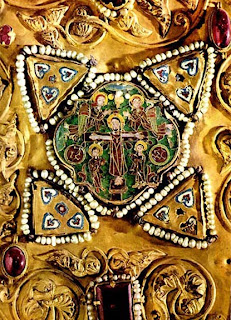By
Heidi Noroozy
 |
| Credit: Morn the Gorn |
Gastronomical
delight is not something I associate with Leipzig, Germany. At least not when I
lived there 30 years ago. Much has changed since then, but in the 1980s, the German
Democratic Republic suffered a chronic shortage of exchangeable currency, which
meant chronic shortages of nearly everything else. A restaurant meal often
began by checking off menu items in conference with the waiter until we hit
upon one whose ingredients were available.
But
Leipzig also had the Auerbachs Keller, which made up for any hardship. Like
Leipzig itself, this underground wine bar is not only steeped in history but
positively drenched with it. And much of that history is literary.
The
historic tavern opened in 1525 on Grimmaische Straße, just off Leipzig’s
marketplace. Its first proprietor was a professor of medicine named Dr. Heinrich
Stromer, also known as Dr. Auerbach, a reference to his birthplace in Germany’s
Upper Palatinate region. In addition to his academic duties (he was also the
rector of Leipzig University), Dr. Auerbach was the personal physician of the
Elector of Saxony, a title granted to the German princes who elected the
emperor. In gratitude for the doctor’s excellent work, the Elector granted him
a license to operate the wine bar.
Almost
immediately, a legend became associated with the Auerbachs Keller. A scholar
named Dr. Johannes Faust, who had grown bored with life, made a pact with the
Devil through the Horned One’s representative, Mephistopheles (aka Mephisto). The
Devil agreed to give Dr. Faust access to unlimited knowledge and worldly
pleasures—but only for the next 24 years (one year for every hour in the day).
At the end of the contract term, the scholar would be required to hand over his
soul to the Devil.
 |
| Faust riding out of the Auerbachs Keller Credit: Deutsche Fotothek |
To
convince Dr. Faust of the plan’s merit, Mephisto invited him to an evening of
revelry in the underground wine bar of the Auerbachs Keller. At the end of the
night, the scholar rode up the stairs on the back of a barrel in a gravity-defying
feat of devilish fun.
On
the tavern’s 100th anniversary in 1625, two paintings were mounted
on the wall, one depicting Faust and Mephisto drinking with students and the
other showing Faust riding the barrel.
By
the 18th century, the Auerbachs Keller had become a well established
hangout for Leipzig University students, and one regular patron went on to
become one of Germany’s leading literary figures: Johann Wolfgang von Goethe.
Inspired by the legend during his student days—and perhaps after staring at the
paintings of Faust and Mephisto through a wine-induced haze—Goethe later wrote a
tragic play titled Faust. He set one
scene in his old hangout, where Mephisto and Faust join a group of students in
a night of drinking until the revelry turns violent. The Devil’s agent casts a
spell on the students, who watch Faust riding out of the tavern on his
legendary barrel.
 |
| Fasskeller of the Auerbachs Keller Credit: Bundesarchiv, Bild 183-1988-0908-307 / CC-BY-SA |
Germany
is a land of long traditions, so when I arrived in Leipzig over 200 years
later, the Auerbachs Keller was still a popular student hangout. It had
expanded to include five rooms, each with a distinctive name: Fasskeller
(Barrel Cellar), Lutherzimmer (Luther Room), Goethezimmer (Goethe Room),
Alt-Leipzig (Old Leipzig), and Großer Keller (Big Cellar). A sixth room, the
Mephisto Bar, was added in 1989. There was even a tribute to Goethe’s version
of the legend in the form of two bronze sculptures at the entrance, one of Mephisto
and Faust and the other of the bewitched students.
My
friends and I usually sipped our drinks in the Fasskeller, with its plain
wooden tables and paintings of the Faust legend along the walls and ceilings.
To my great disappointment, and likely good fortune, I never spotted Mephisto
in the flesh. On occasion, however, I did order a glass of Tokaji, the topaz-colored
wine from Hungary, which is mentioned in Goethe’s play. After all, when you
live in a city so steeped in literary history, it doesn’t hurt to raise a glass
to tradition.















.JPG)













.jpg)



